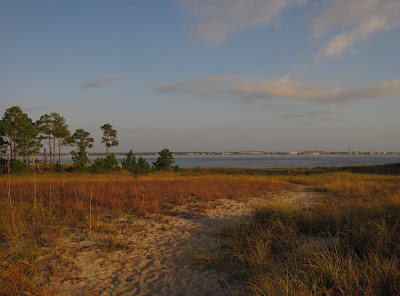Wildlife abounds on Santa Rosa Island, part of the Gulf Islands National Seashore near Pensacola, FL. We've heard about the massive schools of dolphins and the loggerhead sea turtles that nest on these beaches, but we have not seen them yet. But, there certainly is a alot of visible wildlife, if you are paying attention.
There was a huge wash-up of thousands of Portuguese Man-o-wars when we arrived. The wave action was intense at that time. But, a couple of days later, the waves calmed down and there were none in the water and hardly any left on the beach to be found anymore.
However, moon jellies and sea nettles are still very common on the beach and in the waters. But, they are basically harmless. We told Hilina to never touch the blue/purple jellysfish, but she can touch the top of the moon jellies if they are on the beach. She loves to touch the jelly-like surface but seems smart enough to avoid the tentacles.
The bathrooms are full of frogs. As Hilina told me "they are here to help us". Indeed, it must be quite the treat for them to sit on the humid walls and walk right up to snatch moquitoes against a white backdrop.
We saw these tracks all over the beach and wondered what they were. Turns out, they were ghost crabs. I could not take any pictures of the large 4-5" adults, as they will scamper into their burrows at the first signs of people. But, for whatever reason, the little ones are a little more brave.
Ants are very common on the island and very small. They make some pretty cool houses don't you think?
There is so much to discover, if you look carefully. Hilina was very impressed with this sea star and its hundreds of tiny tube feet.
Osprey nest in the tree tops and soar over the bay looking for fish to snatch.
Herons also wander the beaches. In my experience, herons are usually very skittish and it is difficult to get within a 100 feet before they fly off. So, I've rarely had luck photographing them. Not this time though. When I would be out in the water digging for clams and tube worms and doing general bio-searches, this fella would follow me from shore. Perhaps he figured I'd throw him a bite.


























































